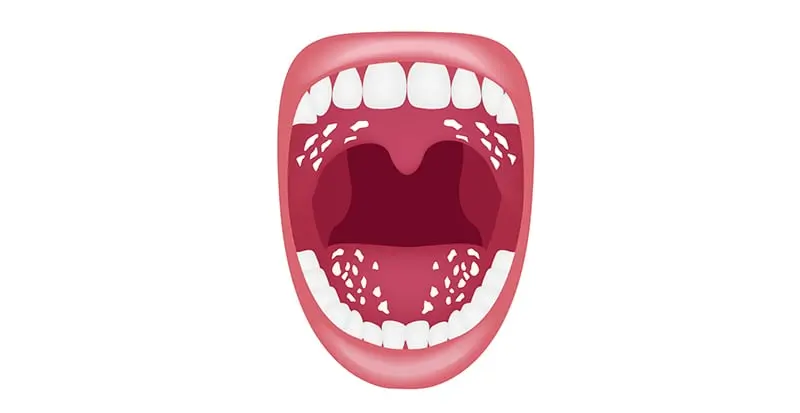What is oral thrush?
Oral candidiasis, also known as oral thrush, is a condition in which the fungus Candida albicans grows on the lining of the mouth. Candida is a normal organism in your mouth but can overgrow and cause symptoms at times. Oral candidiasis produces creamy white lesions on the tongue or inside of the cheeks. It can also spread to the roof of your mouth, your gums, tonsils, or the back of your throat in some cases.¹ Even though oral thrush can affect anyone, it is more common in babies and older adults due to decreased immunity, in people with compromised immune systems or certain health conditions, or in people who take certain treatments. If you're healthy, oral thrush is a minor issue; however, symptoms may be more severe and difficult to control if you have a weak immune system.
What are the causes of oral thrush (oral candidiasis)?
Candida fungus naturally exists in low amounts in the mouth and the digestive system. It usually doesn't cause any issues, but if it aggregates, it can cause oral thrush. Oral candidiasis can occur for a variety of reasons, including:²
Taking antibiotics, especially for a long time or at a high dose.
Wearing dentures that don't fit properly.
Poor dental hygiene
Using inhaled corticosteroid medicine for asthma.
Dry mouth as a result of a medical condition or a medication.
Underlying conditions like iron deficiency, diabetes, HIV or underactive thyroid.
Being in one of the high-risk groups; Infants, young children or the elderly.
Undergoing chemotherapy or radiotherapy to treat cancer
Note that most people already have Candida fungi in their mouth; therefore, oral thrush is not contagious and cannot be passed to others.²
Oral candidiasis symptoms
One might not even notice symptoms of oral thrush in the beginning. Signs and symptoms of oral thrush in children and adults include:¹
Creamy white lesions on the tongue, inner cheeks, roof of the mouth, gums, and tonsils are common symptoms of oral thrush.
Cottage cheese-like blemishes that are slightly elevated.
Loss of taste or having a cottony sensation in your mouth.
Redness, burning, or severe pain that causes difficulty eating or swallowing.
If the lesions are rubbed or scraped, they may bleed slightly.
The corners of your mouth are cracking and crimson.
Irritation, redness and pain under dentures (denture stomatitis)
Lesions may spread downward into the oesophagus, that is, the long, muscular tube stretching from the back of your mouth to your stomach. This may occur only in severe cases, typically related to cancer or an immune system disorder from HIV/AIDS. Symptoms of lesions spreading into the oesophagus include difficulty swallowing and feeling like food is stuck in your throat.¹
Oral thrush treatment
Oral candidiasis causes characteristic bumps that can be simply diagnosed by examining the mouth. However, the doctor may take a biopsy of the afflicted area to confirm the diagnosis. In some cases, the doctor will need to use a throat swab culture or endoscopy to confirm any suspicions that the oral thrush moved downward to your oesophagus. Once diagnoses are confirmed, treatment of oral candidiasis can include some of these prescriptions medicines:³
Amphotericin B: Used to treat severe cases of oral thrush.
Fluconazole: An oral antifungal medication.
Clotrimazole: An antifungal medication that's available as a lozenge.
Itraconazole: Sporanox is an oral antifungal medication used when the patient doesn't respond to other more common treatments.
While oral thrush can go away within a couple of weeks after starting treatment, you need to be extra careful that it may return. Make sure you follow a proper oral hygiene routine that includes rinsing with a mouthwash like Listerine to avoid oral thrush from returning. If oral candidiasis recurs without a recognised cause, it may be attributed to an underlying medical condition.³
Prevention of oral thrush
Oral thrush prevention does not require any extra attention for otherwise healthy individuals. People with a more vulnerable immune system, on the other hand, should take extra precautions.
It's also a good idea to look after your teeth and the rest of your mouth and follow a proper oral hygiene routine. Here are some steps to help you maintain a comprehensive oral hygiene routine that will help you avoid many issues including oral thrush:⁴
Use a soft toothbrush and brush your teeth at least twice a day.
Use floss to clean the spaces between your teeth after every meal to remove plaque and bits of food.
Mouthwash: Rinse your mouth using an antiseptic mouthwash to remove hard-to-reach food particles that a toothbrush may miss.
Make sure you change your toothbrush regularly and even more frequently until the infection clears up.
Go to the dentist regularly so that conditions such as oral thrush, tooth decay or gingivitis can be detected and treated early.
If you wear dentures, make sure you regularly clean them with a toothbrush and a special cleaning solution.
